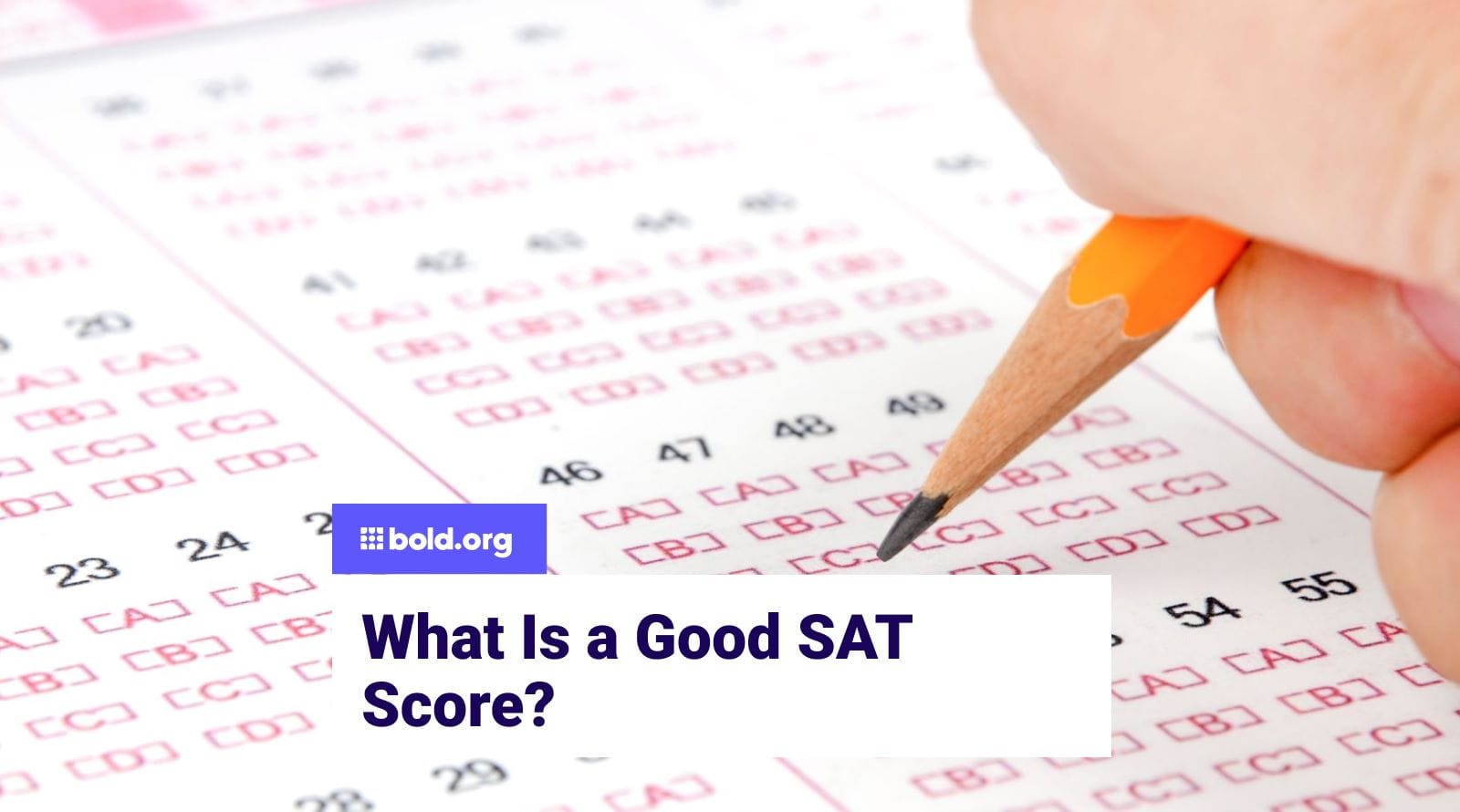Access thousands of exclusive scholarships
for free
Junior year in high school is considered one of the most challenging for students as they take on more advanced classes, begin prepping for college, and prepare to take the SAT. The SAT, or the Scholastic Aptitude Test, is an exam that is commonly used for university admissions purposes in the United States.
This exam has grown into one of the most daunting aspects of the college application process for American high school students and is a major challenge in the preparation for higher education.
If you need help preparing for the SAT, take a look at Learner, one of the best online tutoring services on the market.
Far more popular than other standardized tests like the ACT, the SAT is taken by millions of students nationwide. In 2019 alone, over 2.2 million people took the SAT. With such a large and competitive pool of test takers, the SAT has been a major source of discussion in recent years and has evolved greatly since its establishment.
For instance, despite its name, the SAT is no longer just an aptitude test. Originally, the test was intended to uncover the hidden potential in students who may have come from underprivileged backgrounds and would otherwise not be pushed toward the pursuit of higher education. Over time, however, the test has transformed immensely. Its goal now is to measure and assess developed reasoning, examining what has been learned rather than what is inherent.
Get Matched to Thousands of Scholarships
Create your Bold.org profile to access thousands of exclusive scholarships, available only on Bold.org.
Create Free ProfileThese changes have made the test a subject of scrutiny in recent years. The exam's intention to impartially measure a student's learned capabilities presupposes a certain level of educational and socioeconomic equality when, in reality, education in the United States is not equally distributed.
Not only do some school districts have more funds and thus more access to better learning tools, but they may also have smaller classes and better facilities and teachers. Furthermore, students with more financial security are able to afford SAT prep courses as well as practice tests and books and can even pay to take the exam multiple times. This not only prevents those from lower income backgrounds from receiving a good SAT score and getting accepted to more selective collegiate institutions, but it can lead to further socioeconomic, political, and even racial division.
Consequently, the average SAT score ranges across the nation are vast, making it increasingly more difficult to consider SAT scores 'standardized test scores.' The exam has begun to fall out of popularity within the college application sphere.
To learn about how to best study for the SAT, visit Bold.org's Scholarship Blog for tips and tricks on how to best prepare for the SAT.
Schools across the nation have begun to recognize that SAT scores are influenced by a number of factors that are not indicative of a student's intelligence or college preparedness. Many institutions have decided to make the SAT optional, and some don't accept SAT scores at all.
Receiving a good SAT score can be useful to an application and can set you apart from other applicants. Receiving a good SAT score can useful to an application, and can set you apart from other applicants. Similarly, a good SAT score can be used for scholarships, specialty programs, and school transfers. In this way, studying to receive a good SAT score can be worth the trouble.
Moreover, although a good SAT score is far from the only criterion necessary to be accepted into an accredited collegiate institution, it can be useful to students aiming for target schools that are selective.
If you are concerned about the inequity of the exam, it is important to note that getting a good SAT score is still achievable for all students. As for the cost of the exam itself, it is possible to waive the fees for students with financial need, allowing them to focus entirely on studying for the test. Additionally, there are many resources available to students of all backgrounds, so consider conducting research and speaking with your school's counselor to determine the best option for you.
Need help paying for college? At Bold.org, you can apply to exclusive scholarships just for you. Sign up here to see which scholarships you are eligible to apply for today.
If you are considering taking the SAT, you may have questions about the exam setup, scoring, and preparation process. To learn more about the test, check out this comprehensive guide to the SAT.
Have you heard of SAT Subject Tests? If not, check out our blog, What Are SAT Subject Tests?, to see if they're right for you.

How to Sign Up for the SAT
In order to sign up for the SAT, cancel registration, check SAT scores, find study materials, and learn any necessary information about the exam, students must navigate to the College Board website. This is the main center for anything related to the SAT.
On this website, you must make an account in order to start the registration process. Before you register, be sure to have a valid ID and a form of payment ready for the registration fee. Once you access the website, follow the required steps to complete the signup process.
How Much Does the SAT Cost?
As detailed on the College Board's website, registration for the SAT currently costs $60. It can vary for international students, and an extra $30 is added to students who register after the registration deadline. However, prospective SAT-takers can also submit a fee waiver in order to avoid the $60 charge.
Changing your SAT test center and canceling your registration both require a payment of $25. Additionally, canceling your registration after the deadline costs $35.
How to Study for the SAT
Studying for the exam is the key to getting a good SAT score. All students have different learning methods that work best for them, so it is important to consider the best method to optimize your personal learning. For instance, some students learn best by studying with others in a discussion environment. By contrast, others may prefer to study on their own with flashcards.
While study methods may vary between students, the College Board recommends several studying tools and methods that are particularly conducive to achieving a good SAT score.
First, in addition to paying attention in school classes, make a study schedule for yourself and stick to it. The College Board recommends that students begin the studying process early. On average, they suggest that students begin studying 2-3 months before their testing date. Make sure you take this into account when you register for the exam so that you give yourself ample time to study for the SAT.
Next, partnering with the educational website Khan Academy, the College Board now offers a free study program for prospective SAT test takers. So long as students have internet access, this study program can make the exam somewhat more equitable. Moreover, the SAT will become completely digital for international students in 2023 and for students in the United States by 2024. Studying online can be beneficial to future students since it simulates an environment closer to the actual exam.
Through Khan Academy, students can make a personalized study plan that takes into account their performance on any previous SAT exams as well as the PSAT/NMSQT (Preliminary SAT/National Merit Scholarship Qualifying Test). This latter exam, which is generally taken by sophomores and juniors in high school, is taken before the actual SAT and is meant to provide a baseline of college readiness. It is a slightly shorter and easier version of the SAT that can help students gauge their preparedness and can even lead to other benefits, like scholarships for high scorers.
Through this Khan Academy study program, students can practice their evidence-based reading, writing, language, and mathematical skills to achieve their target SAT scores.
Additionally, the College Board recommends students study by taking full-length practice tests that are timed, just like the real SAT. Khan Academy offers practice test options, and students can also purchase or rent physical practice test booklets. If you are looking for a study booklet, speak with your school's counselor or librarian to see if they can help you gain access.
Once again, studying is imperative to getting a good SAT score and can improve your score immensely.

How Is the SAT Scored?
According to the College Board website, the SAT score range is currently from 400-1600, and a student's composite score is made up of two sections: evidence-based reading and writing and mathematics. These two sections have a score range of 200-800 each. Your score in each section is dependent on the number of questions answered correctly. This number is then converted to a scale of 200-800 and can vary slightly based on the version of the exam being taken.
The entire test score is made by converting the total number of questions answered correctly on a scale of 10-40. To find the Evidence-Based Reading and Writing section score, the test scores for reading, writing, and language are multiplied by ten and then added together. To get the math section score, the test score is multiplied by 20.
Once your examination has been scored and you navigate to your score page, you can see an in-depth breakdown of your SAT score. This will show the number of questions you answered correctly as well as the overall results you received for each section.
What Is an Average SAT Score?
In the year 2021, the average SAT score was reported as 1060. This report also showed that students scored an average of 533 on the evidence-based reading and writing section and 528 on the mathematics section.
Average SAT scores can vary greatly by location as well, especially when considering the socioeconomic status of a particular location. For instance, the SAT score range of a county with less educational funding may be lower than the SAT score range of a county that receives more educational funding. This illustrates that what qualifies as a good SAT score can vary.
Did you score well on the SAT and plan to apply for college? Check out these academic scholarships now!
What Is a High Score On the SAT?
The highest possible score for SAT test takers to earn is 1600, but what qualifies as a high score is subjective. Considering that the average score on the SAT is 1050, a high score could be considered anything above 1050. By contrast, certain states, counties, and even high schools may have a higher or lower average SAT score.
According to the College Board's statistics, a score of 1350 would put you roughly in the top 10% of test takers and can make you a strong applicant for more selective schools. If you achieve a target score of 1350 or above, you can easily consider it a high score.
Many selective schools have an even higher average SAT score range among their students. Below is a list of the average SAT scores of students attending the top ten universities in the United States (as ranked by the U.S. News and World Report):
Princeton University: 1450-1570
Columbia University: 1510-1560
Harvard University: 1460-1580
Massachusetts Institute of Technology: 1535
Yale University: 1460-1580
University of Chicago: 1520
University of Pennsylvania: 1490-1560
California Institute of Technology: 1545
Duke University: 1510
Johns Hopkins University: 1505
If your SAT score falls below the average SAT scores of your target schools, don't be discouraged. Even if you do not achieve what you believe to be a good SAT score, you can still get into your target school. Remember that a student's SAT score is not the only criterion that college admissions officers look at when reviewing an application. Factors like grades, extracurriculars, application essays, and letters of recommendation are all important and can make you a viable candidate despite not having the highest test scores.
Furthermore, as many schools begin to do away with the SAT as a part of their admissions criterion, receiving a good SAT score may not be as important as it once was.

How Long Does It Take to Get SAT Scores?
The SAT is scored fairly quickly since students are often up against college application deadlines and are eager to see their results. On average, it takes 2-4 weeks for SAT scores to be released, but where you fall on this range can depend on when you take your examination.
For instance, if you take the exam on a Sunday, you will most likely receive your test scores two weeks after your testing date. If you take the exam at school on a weekday, it will likely take longer, and you will receive your SAT score roughly three weeks after your testing date. Similarly, if you take your exam during the summer season, it will take even longer for you to receive your SAT score.
It is important to note that the SAT scores the optional essay portion of the exam separately from the multiple choice portion. If you have written or are planning to write an essay for the SAT, your essay score will arrive a few days later than the rest of your SAT score.
How to Check SAT Scores
When you register for the SAT, you will typically make an account on the College Board website. Once you have an account, you can use this portal to access all relevant information for testing, college admissions, and scores.
You will receive an email when your SAT score is available to be viewed. Once you receive this email, you can sign in to your aforementioned account to check your results.
How long is the SAT?
The SAT has spent many years as the most important exam for college admissions. Although this is beginning to change, the test still holds a fair amount of weight. Thus, it is quite long.
Not including breaks, the length of the entire SAT is 180 minutes. There is also an optional essay portion that is an additional 50 minutes. If you choose to take the essay, your total SAT time will be 230 minutes.
Here is a breakdown of the length of each section from the College Board:
Reading:
65-minute section with 52 questions (75 seconds per question)
Writing and language:
35-minute section with 44 questions (about 48 seconds per question)
Math – no calculator:
25-minute section with 20 questions (75 seconds per question)
Math – calculator:
55-minute section with 38 questions (about 87 seconds per question)
Essay (optional):
50 minutes, one essay
Between some of the SAT sections, proctors will also give test takers a short break. The first break is 10 minutes long and takes place between the evidence-based reading test and the writing and language test.
Next, there is a 5-minute break between the two portions of the math section. Some SAT versions have an additional 20-minute section, in which case you will also get a 2-minute break after the calculator portion of the math test. You will also receive a quick break before the optional essay section.
Because of the length of the exam, you should consider bringing a light snack and some water. This will prevent you from becoming hungry or dehydrated and will allow you to give your best effort throughout all sections of the test.

Frequently Asked Questions About the SAT
How many questions are on the SAT?
In total, the SAT is 154 questions long. On average, this gives test takers roughly 70 seconds per question, although this value can fluctuate depending on how much time is allotted to each section and the number of questions in that section. For instance, the reading section of the SAT is 65 minutes long with 52 questions, giving students about 75 seconds per question.
If you have studied hard and want to receive a good SAT score, it is important to be conscious of the time as you take the exam. Your exam proctor will likely alert you of how much time you have left at certain points in the exam process, but studying by taking timed practice exams is a good way to ensure that you become familiar with the timing of the exam. This way, you can increase your chances of achieving a good SAT score.
What calculators are allowed on the SAT?
For the calculator portion of the math exam, all scientific calculators and 4-function calculators are acceptable (although the latter is not recommended). The SAT also allows most graphic calculators so long as they do not have features listed under the College Board's Unacceptable Calculators list.
Check out the SAT's guidelines on calculators to ensure that yours is acceptable.
How do you send SAT scores to colleges?
To send your SAT scores, first log into your College Board account and navigate to the "Send SAT Scores" page.
Next, select the colleges you want to send your scores to by using the college search bar and clicking on the schools that you wish to add to your SAT score recipients list.
For each recipient that you add, you can send either all your scores (if you have taken multiple SAT exams) or even just some of your scores.
You can choose to send only your best score; however, some college admissions require that you send in all of your scores. Seeing a student's full SAT score range across several tests can indicate a high level of commitment and hard work to a college admissions officer, so if your initial score is much lower than your final SAT score, do not feel concerned about submitting it.
As you select the scores you plan to send, you can view your prospective school's policy regarding which SAT scores it requires.
Finally, review your order and agree to the terms and conditions. Then, check out.
It is important to note that when you take the SAT on a weekend, you can send four free score reports. You can designate which schools to add to your recipient list at any time leading up to your exam date. You can even wait until nine days after the test to use your free score reports.
After this time period, or if you plan to send more than four reports, there is a fee of $12.
How do you cancel SAT registration?
To cancel your registration, navigate to the College Board's website, and sign in to your account. Select the registration that you wish to cancel and from the "I would like to" menu, select cancel registration. You can also register for a new date from this point if you would like.
If you cancel your registration before or on your exam date, you will receive a full registration refund of $60; however, you will still have to pay a cancellation fee of $25. If you cancel your registration after the cancellation deadline has passed, the fee will be $35.
Can you take the SAT after high school?
The SAT is not exclusive to high school students, and prospective test takers are welcome to register, whether they are in high school or not. There are several reasons why a high school graduate may want to take the SAT.
First, students who want to attend college sometime after they have graduated high school may find that they need to take the exam to apply to some schools. Similarly, students transferring to a new college may find that their new prospective school also requires applicants to submit SAT scores.
Finally, although it is rare, some job applications even require that applicants send in their SAT scores as part of the application process. Although this practice is not very common, it is not unheard of, so getting your standardized test scores after high school may be a necessary step for some job seekers.
To start earning scholarships through Bold.org, check out our scholarship search page, which allows you to browse a list of exclusive scholarships.


